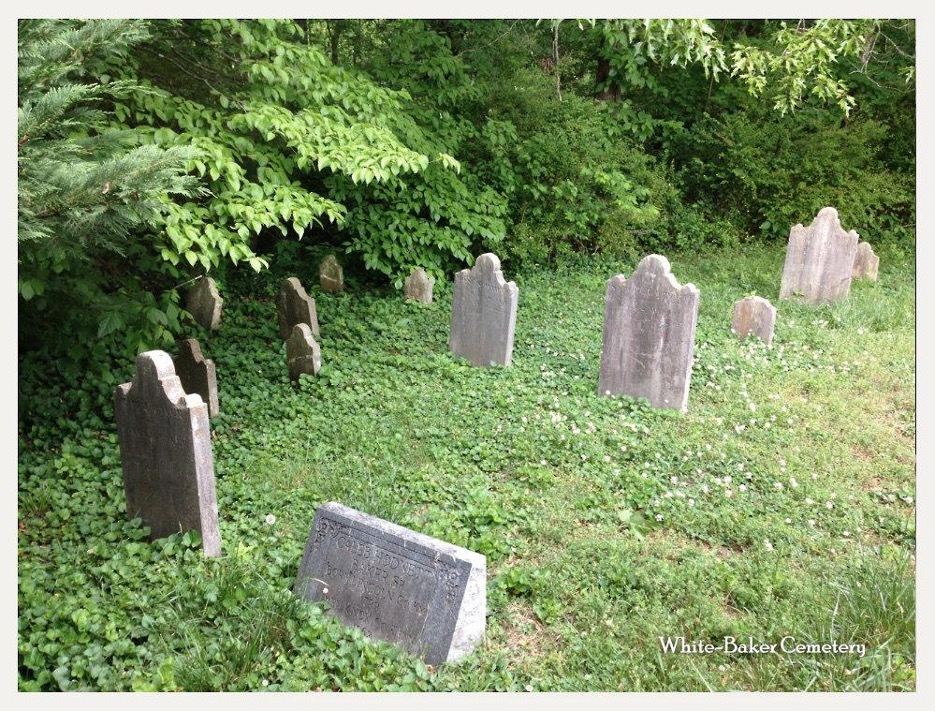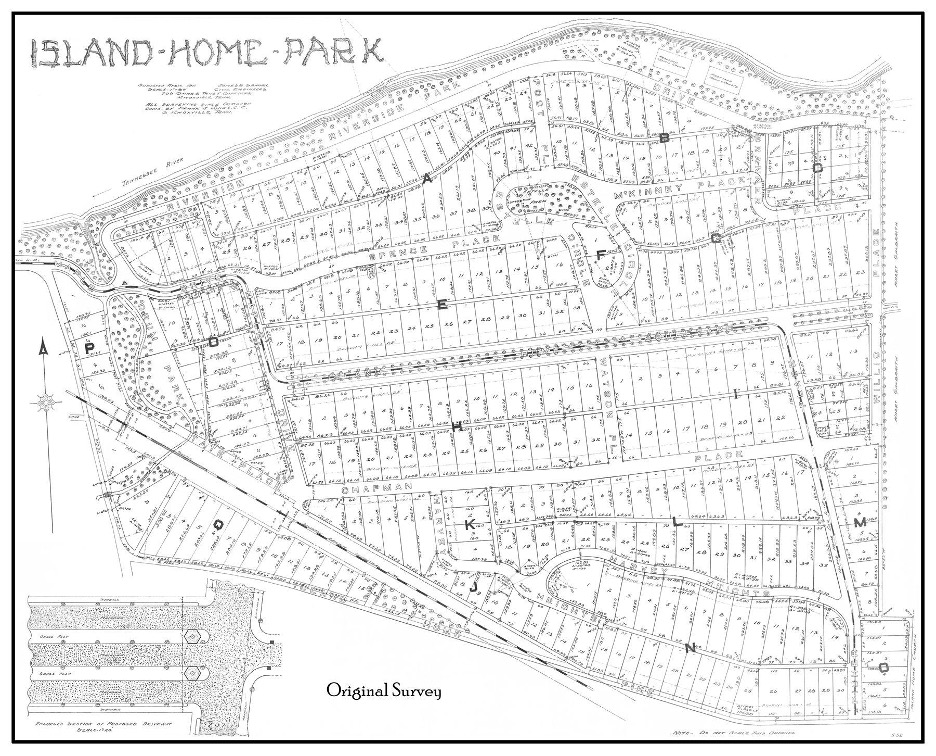by Leo C. Scalf
April 22, 2016
The Island Home Park community lies on approximately one hundred and twenty acres of land located in Knox County within the city limits of Knoxville, Tennessee. The first known transaction involving the land that is now Island Home Park was in the form of a treaty establishing a large block of land as a part of the state of North Carolina. James White was granted ownership of a portion of the land and the remainder was made available for settling.
In the late 1700s and early 1800s, the area saw an influx of Revolutionary War veterans. The areas settled by the veterans included land that is now a part of South Knoxville. That portion of the land was accessible only by ferry. After settling in the area, a process involving surveys and grants established legal ownership in the form of a deed for the land they had heretofore merely claimed as their own.
On September 14, 1808, Revolutionary War Grant 320, awarded a 630 acre plot of land to John McElderry for the sum of $567.22. For reasons unknown, his name is listed on the grant as John McEdlet. Governor John Sevier signed the Grant. It constituted the first record of official ownership of the land that would become Island Home Park. Thousands of acres along the south side of the river were settled and claimed by those who would establish themselves as some of the oldest and most influential families in Knoxville.

John McElderry owned the property until January 2, 1815. On that date, just a few days after the Battle of New Orleans ended the War of 1812, the property was officially transferred to Brigadier General Thomas A. Smith. Brigadier General Smith was on leave in Knoxville when the war ended.
At this point in its history, the property can again be tied, at least indirectly, to James White. His daughter, Cynthia Berry White, had married Brigadier General Smith in 1807. The purchase of the property by General and Mrs. Smith seems to have been one of convenience. On January 9, 1815, only a few days after its purchase, the property was sold to Moses White and the Smiths moved to St. Louis, Missouri. Moses was a brother to Cynthia and son to James White. The property changed hands quickly but ownership by a member of the White family remained.
Moses White married Isabella McNutt and they had twelve children. During his lifetime, he acquired additional properties that resulted in an estate in excess of 1500 acres. He died on April 22, 1830. Twelve children and a large estate resulted in the need for a rather detailed and extensive last will and testament. A portion of that will read that “one quarter of an acre including the grave or burying ground on the place where I now live for a grave yard for use of the family forever” resulted in the creation of the White-Baker Cemetery. Moses White was laid to rest in a cemetery created by his own passing. At this writing, it remains intact in a back yard on Hackman Street about one quarter of a mile south of Island Home Park.

The Moses White estate was settled by his son George M. White. As a part of the settlement, 728 acres of land became the property of Moses’ daughter Mary Lawson White Baker and her husband Caleb Hodnett Baker. Caleb was married to three different women and fathered nine children. In 1862, Caleb was killed in the Civil War and was buried in the White-Baker Cemetery . His will left one hundred and twenty acres of his land to three of his daughters, Melinda Baker, Mary L. Baker Ingles and Minerva Baker Jourolman,. The three daughters and their families settled on and farmed the exact parcel of land that would later become Island Home Park. The daughters remained on the property for approximately 16 years then each of them sold their portion of the land to Perez Dickinson in 1878.

Perez Dickinson was born in Amherst, Massachusetts on February 25, 1813 and moved to Knoxville, Tennessee in about 1830. He made his home on Main Street in downtown Knoxville and established himself as a successful mercantile businessman. His success allowed him to begin purchasing land in south Knox County. His first purchase was Williams Island, a 200 acre island just off the southern bank of the Tennessee River. The property was purchased from John Williams and Rufus McClung on October 3, 1870. The acquisition of an additional four hundred acres of land over the next five years resulted in a 600 acre estate that was considered to be one of the finest breeding farms in the South. The estate was assembled from properties purchased from the Williams, Jones, Keyhill, Patterson, Baker and Gilbert families and was given the name Island Home Farm. The farm held the land that would later become Ijams Nature Center, the Tennessee School for the Deaf, Meads Quarry , the Downtown Knoxville Airport and the Island Home Park neighborhood.
Perez Dickinson died on July 17, 1901. His nephew, Perez Dickinson Cowan, was named as executor of the estate. On February 8, 1905, Mr. Cowan sold the largest portion of the real property amassed by his uncle to Harry Harris Galbraith.
H.H. Galbraith and his wife Essie M. Plyley Galbraith held private ownership of the estate property and on May 10, 1911 they sold 120 acres of that property for $60,000.00 to Island Home Park Company, a business they officially established three days after the sale. F. J. Jones, a civil engineer, surveyed and plotted the alleys, roadways and lots for a new community, Island Home Park.

Island Home Park most probably owes its beginnings to the construction of the Gay Street Bridge. The bridge was completed in 1898 and included trolley tracks to serve south Knoxville. Upon completion, the tracks extended only a short distance beyond the south end of the bridge, but by 1913 the tracks had been extended to the Island Home Park entrance. A turn around for the trolley was constructed just inside the community. Sometime later, tracks were laid down the center of Island Home Boulevard and remain more or less intact buried beneath the boulevard’s grassy median.

The first lot was sold on May 25, 1911. Lot #26 on North Island Home Pike was sold to Abner L. and Mary E. Holton. Abner, Mary and their new baby girl moved into their home and were listed in the “Knoxville Tennessee Directory” as living at 172 Island Home Pike from 1912 to 1914. At this writing 172 Island Home Pike is now 2223 Island Home Avenue.
The first lot sold and house constructed as a part of Island Home Park was not the first house built inside the boundaries of the community. Around 1909 or 1910, before the Island Home Park Company was established, H. H. Galbraith built a house just inside the now iconic Island Home pillars. It occupied what would later be designated as Lots #1 and #2 in Block P on Island Home Pike. There has been speculation that the house was built as a model home but such claims remain unsubstantiated. It was sold on January 13, 1913 to Mr. T. E. Plyley and its Island Home Pike address later became and remains 1900 Maplewood Drive.

By 1939 there were approximately one hundred homes in Island Home Park, a number well below initial expectations. Three lots were sold from the time of the 1929 stock market crash through the end of 1931. During that same period of time, eleven Quit Claim Deeds were filed. The Great Depression had a huge negative impact on the growth of the neighborhood. Roadways shown in the original plans for the community were incomplete or missing. Spence Place ended at Watson Place and Estelle Circle did not exist. Willis Place fronted the property of The Tennessee School for the Deaf and led to Dickinson Island. Harvey Heights (Hillisboro Heights) ended before reaching Maplewood. Branner Place, McKinney Place, Tate Place and Riverside Drive were never constructed.

The neighborhood didn’t have the best of beginnings, but after 1940, Island Home Park proved itself to be a resilient community. Estelle Circle was constructed and Spence Place and Hillsboro Heights were extended. Homes were built in most, if not all, decades following the 1930s. The result is a community that has its beginnings during the heyday of the classic bungalow, but includes mid century modern, smaller post World War II houses, the carport ranch houses of the later part of the century, and newer homes that took their styling cues from the original one hundred. The homes, and more importantly the people, of Island Home Park form what has become a diverse and robust community.